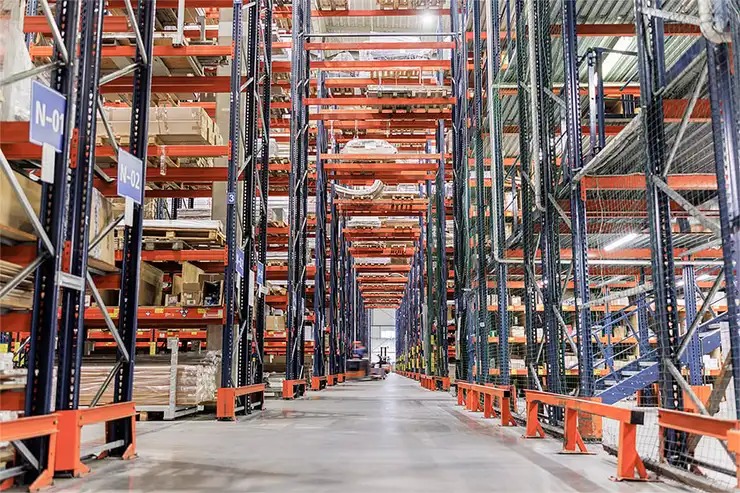5 min read
How to Make Your Business Resilient to Supply Chain Disruptions
By:
Cubeler en-ca
April 12, 2023 9:00:00 EDT AM

Gain more insight on how to make your business resilient to supply chain disruptions.
Table of Contents
With over a quarter of businesses expecting supply chain issues over the next few months, these questions are top of mind as SMEs head into the end of the first quarter.
The good news is, there are strategies to improve supply chain management, making one’s business more resilient to global disruptions.
What is causing the supply chain issues in Canada?
International supply chain disruptions, caused by COVID-19 aftereffects and more, hindered Canadian production while raising costs last year.
Canadian manufacturers said they lost approximately $10.5 billion in sales and were facing almost $1 billion in increased costs.
With nine out of 10 companies having been impacted, these negative effects were felt across a variety of sectors, including retail, manufacturing, construction, and science and technology.
Global supply chain problems have been affecting resources critical to Canadian business operations, including:
-
Raw Materials: Many SMEs rely on raw materials from international suppliers to produce their goods. Businesses have been experiencing shortages and slowdowns in the delivery of raw materials, resulting in higher costs and production delays.
-
Transportation: Transportation has also been hindered, leading to delays and increased costs for shipping and logistics. This has made it challenging for SMEs to receive and deliver products on time, lowering customer satisfaction and revenue.
-
Labour: Lockdowns and travel restrictions limited the ability of SMEs to hire and train employees during the pandemic. This has resulted in labour shortages and increased labour costs, further affecting the bottom line. ‘New normals’ of remote and hybrid work continue to hinder in-person operations.
-
Technology: The disruptions have also highlighted the importance of technology in supply chain management. SMEs without robust digital systems have struggled to track inventory, forecast demand, and manage logistics, putting them at a competitive disadvantage. With increased costs creating more precarity, businesses cannot always afford to fund technological upgrades.
-
Financing: Supply chain issues have led to increased financing costs for SMEs, as they seek additional funding to cover unexpected costs. This has put a strain on the financial health of many businesses, leading to cash flow problems and the need to restructure debt.
Supply chain disruptions in the retail sector
The supply chain disruptions of the past few years have had long-term destabilizing effects on Canadian retailers.
For example, many of them experienced both inventory gluts and shortages last year. Shortages resulted in higher prices and longer wait times for customers, leading to reduced sales and revenue.
In 2022, grocers in particular faced challenges related to European supply chain disruptions. With Ukraine having been the world’s fifth largest wheat exporter and fourth largest corn exporter, grain prices were driven up with lowered supply, affecting popular products like bread, breakfast cereals, and pet foods, as well as meat and dairy products—since most animal feed uses grain.
Extreme weather events such as droughts have also negatively impacted grocers, decreasing fruit, vegetable, and tree-nut supplies.
Supply chain issues in the manufacturing sector
Manufacturing companies have been among the hardest hit by supply chain issues. The shortage of raw materials and components have been generating production delays, leading to decreased output and revenue.
In addition, transportation and logistics slowdowns have been making it challenging to deliver finished products to customers, resulting in further revenue loss.
These hinderances have had consequences for manufacturing businesses: 81% increased their own delivery time, 75% increased their prices, 60% found new suppliers, 46% paid premiums to get supplies on time, and 40% lost customers or sales.
Difficulties accessing critical materials, quickly rising energy costs, and price increases of key inputs are some of the issues the manufacturing sector continues to face.
Supply chain issues in the construction sector
Along with manufacturing, Canada’s construction industry has also been severely impacted by supply chain disruptions resulting from pandemic-related shut down periods for shipping companies and critical suppliers, like lumber mills supplying wood, as well as manufacturers providing plumbing for homes and computer chips for appliances.
Construction companies have been experiencing challenges sourcing materials, including lumber and steel, as well as securing labour, thereby delaying home closings and rendering construction timelines unpredictable.
Prices soared on many materials, adding tens of thousands of dollars onto home construction costs.
Consequently, 86% of construction businesses increased their own delivery time, 71% increased their prices, 56% found new suppliers, 54% paid premiums to get supplies on time, and 52% lost customers or sales.
Supply chain issues in science and technology
Supply chain problems have also been impacting science and technology companies, for example, with significant increases to computer component prices and difficulties securing hardware on time. There have been delays in the production of smartphones, laptops, and other popular devices.
Moreover, as many professionals transitioned to remote work, personal computing device sales rose 11% globally throughout the pandemic, increasing pressure on already-strained components manufacturers. In particular there have been extreme shortages of semiconductors, a critical computing component.
Why should businesses source locally?
87% of Canadian entrepreneurs with suppliers outside of Canada reported having supply chain problems, while only 59% of entrepreneurs with exclusively Canadian suppliers experienced issues following the onset of the COVID-19 pandemic.
Many factors are contributing to high levels of uncertainty moving into 2023, such as rapidly shifting trade patterns, human- and climate-caused supply chain issues, geopolitical risk, and increased consolidation in transportation modes.
Transitioning from global to local supply chains is one way to help future-proof a business in the face of these ongoing obstacles.

How to shift to local supply chains
Local supply chains source, produce, and transport their inventories from businesses within their regions or communities. When transitioning to local supply chains, SMEs can loosely follow a step-by-step approach.
1. Build a business case
SMEs may justify the decision to shift to local suppliers by considering:
- Local manufacturing standards and legislation i.e. local supply chains are more likely to be aligned
- Social aspects e.g. supporting the local economy and labour market
- Environmental sustainability e.g. emissions and material reductions
- Competitive advantage e.g. being more quick and agile, decreasing delivery times
- Increased transparency and access to suppliers
- Cost reduction i.e. shipping products from overseas can incur tariffs and more transportation expenses, and are much more exposed to the risk of costly disruptions
2. Audit, research, and assessment
SMEs must analyze what supplies they use and where they source them from. Then, they may look for and assess local alternatives, considering location, history and operations, performance, quality of goods and services, certifications, licenses, staffing, etc. An employee, team, or department e.g. purchasing could carry out the supplier research and evaluation using a defined criteria e.g. price, quality, delivery time, sustainability, etc.
Otherwise, companies may opt for consultants for this process, such as those with legal knowledge. Companies may also engage with local trade organizations, as well as business associations and directories to network and discover suppliers. Online platforms like Thomasnet.com can also be used to find local suppliers.
3. Implementation
The responsibility of implementation will cut across various teams and departments as adjustments will need to be made in supply chain operations, including changes to logistics, inventory management, and delivery processes.
Furthermore, ’going local’ can be an integrated process across all departments, aligning with a business’ vision and core values e.g. quality and sustainability.
SMEs will need to engage with new suppliers and set contractual agreements designating joint objectives and requirements. Likewise, contracts with current suppliers may need to be adjusted or concluded.
4. Communication
Companies ought to communicate the shift to local supply chains to their stakeholders, including employees and customers, indicating how the transition will or won’t affect them. This is also an opportunity to collect feedback and suggestions.
5. Monitoring and evaluation
Once the shift to local supply chains is complete, businesses must monitor and evaluate performance. This can include tracking the supplier criteria defined above and making adjustments as needed.
Final thoughts: Making your business resilient to supply chain disruptions
Global supply chain issues continue to be a challenge for Canadian SMEs across major industries: retail, manufacturing, construction, and science and technology.
Shifting from global to local supply chains is one way to enhance your business’ resilience to disruptions—with added value. And, it doesn’t have to be an all-or-nothing approach.
Simply increasing the amount of local suppliers in your supplier mix may already yield positive results for your business.
This is just a taste of the insights you can gain from Cubeler
Sign up now with Cubeler for no-cost access to Cubeler Business Hub's in-depth business intel reports and cutting-edge SME tools.


/cubeler-insights-blog-1381x907.jpg)